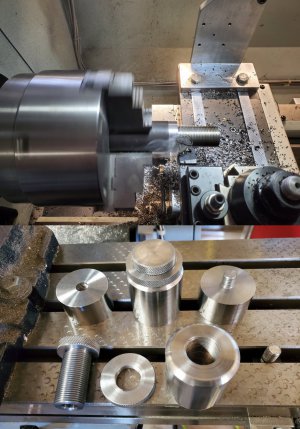Hi All,
I've never used anything but HSS. Watching some videos focused on inside and outside threading, it seemed to me the inserts did a much better job at threading.
Be unreasonably observant when looking at how convenient, easy, and effective things are that happen on YouTube..... You see what you see, but you also miss what you miss.
Insert tooling is undoubtedly more convenient. You don't have to grind the tool. How much more convenient is up to you. It's pretty fast to grind a tool, depending on the size of the HSS blank, but like anything, the more you do it, the easier and faster it gets. But the bottom line is that you still have to do it. On the other hand, the insert holder costs real money, the tool post for it costs real money, the inserts themselves cost real money.... It adds up. Do you need the convenience? My contention is that there are some things that modern tools can do which HSS ground cutters just can not. So I do keep both.
In terms of cutting threads- That is a VERY big ask for a small to medium sized lathe, as you're driving a form tool into whatever you're threading. One of the drawbacks of insert tooling is that it's not that sharp. On a smaller lathe, that means higher horsepower, more tool pressure, more deflection, more headaches. On larger commercial machines, with a gazillion horsepowers and a ton (or tons) of cast iron to keep stuff from deflecting, that same "not sharp" property can absolutely leave you a much better finish in many materials. Almost like it's been cut and burnished in one operation. Not to mention, a lot of the inserts you see in somewhat larger machines, they'll be "topping" inserts. You don't undersize the stock for a thread with these, you leave it at nominal. Then you thread until the OD of the threads (with a regular micrometer) reads correctly for the finished thread. Boom, done. That's a LOT of engagement of a form tool, a very high tool pressure load, chatter,stalls, etc on a small lathe.
I'd highly recommend that you try this, and see what happens on YOUR lathe, on YOUR preference of materials. Basically, how is it going to work for you. I'm going to also highly recommend that you do not jump in with both feet. Grab a suitable holder and threading insert (or several, you can' round or point the tip on these for different pitches the way you can with HSS, so you'll need several inserts...) Depending on "everything", you might like that insert and never go back. You might find that the insert doesn't do as well as the tools you grind. Or you might find as I did, the insert approach works kinda OKish maybe sorta.... And external threading tools are dead easy to make and keep sharpened. So HSS it is for me. On the other hand, internal threading tools? Crazy lot of grinding to be done, one incident of poor judgement can wreck an internal threading tool right at the grinder, before it ever hits the work, there's limited sharpenings available, and the length is somewhat limited in my case just due to the size of HSS that I can hold. So in that case, I prefer to live with the drawbacks of the inserts. (And the benefits too of course... I'm not negating that). So the inconvenience of grinding internal threading tools just kind of tips the scales for me.
You also may (or may not....) run into issues down the road as well, if/when you get into fancer alloys, there are a lot of materials which are simply more aggressive than what HSS is able to deal with. In that case, low power, small cuts, hot strings, and all kinds of other compromises must be dealt with, because HSS is no good if you can only cut for a minute or two on a tool before it's dead..... So, inserts are the winner there as well.
I would strongly recommend that you at least consider David Best's book. This forum can and will get you what you need to know for an insert holder or two. If you're going to run with it to any degree however, while there is no one complete infallable authority on the subject, Dave's book is very useful. Whether you go with all inserts, or just a few, his will save you enough money to cover it's self in no time flat. Mistakes in this area get expensive, fast.


